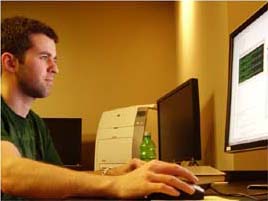Transfer Student Bill Spracklin '09 Plans Future Work in Artificial Intelligence
 "I was about nine years old when I started
to learn how to program," Bill Spracklin said. "I picked it up on my
own. I was big into video games, and I wanted to figure out how to make
them."
"I was about nine years old when I started
to learn how to program," Bill Spracklin said. "I picked it up on my
own. I was big into video games, and I wanted to figure out how to make
them."
Now Bill is a Computer Science major at the College, having transferred in after three years at nearby Thomas Nelson Community College.
While earning his associate's degree there, "I was a full-time employee at Cox Cable," Bill said. "I would go into the homes of twelve strangers a day. It gave me a lot of great stories. In their own homes, people aren't afraid to be completely themselves."
As a student at TNCC, Bill knew he wanted to transfer to the College. When the time came, "It was an easy process. The comp. sci. website really helped out," he said. "They had a list of classes that transfers should take before applying. And the College as a whole has a transfer guide that was really helpful, too."
It's clear Bill hasn't lost his early interest in computer science. "It's a really interesting subject. There's a lot of math, believe it or not. You're required to take three math classes, and I intend on going for a math minor. It's not like, say, calculus, but there's a lot of math and problem-solving. There's a bit of a learning curve, which throws some people off, but I find it very rewarding. You can take just a few instructions and use them to solve very big problems."
Bill's affinity for his subject allowed him to work as the consultant at the College's Interactive Graphics Lab, a collection of high-powered graphics workstations based in Swem Library. "I was far ahead on a project, and they just hired me on to help other people out. Right now, we're working on a ray-tracing project - it's a technology used for graphics in movies and science visualization. You're making part of the the technology behind the programs. We program spheres and work with refraction, making clear objects that bend light, tweaking the algorithms to get it just right." In the Graphics Lab, Bill has also done work on "flocking," which is "the simulation of animal packs, like birds and fish, and how they tend to move together in complicated patterns."
Because the College has master's and doctoral programs in computer science, Bill is able to work alongside graduate students. "My graphics class is only like, fourteen people. At most, classes have twenty or twenty-five students in them. The graduate students really raise the bar, though. Whenever I feel like I'm doing well, I talk to the graduates, and they've always got incredible ideas. Then I go back and rethink my own projects."
Bill has also found the College's faculty to be supportive, particularly Professor Phil Kearns and his graphics instructor, John van Rosendale.
After he graduates, Bill would like to pursue work in the artificial intelligence community. "It's an up-and-coming field, and the technology is improving really quickly. There's a lot you can do with it, a lot of practical applications."














